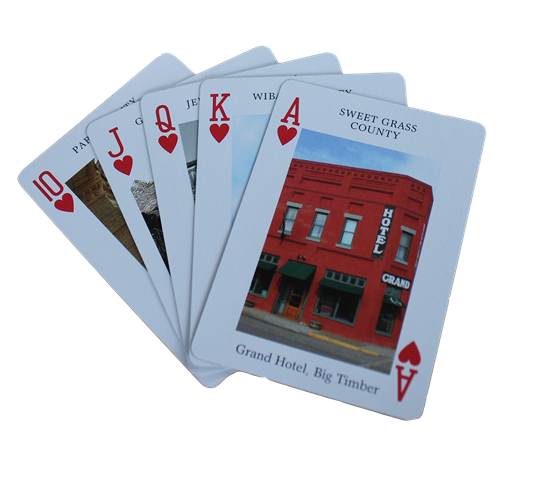
Playing card games go back a long way in history. Most scholars attribute the first playing cards to China in the 9th century AD. There is undoubtedly as many games to play with the standard modern deck of 52 cards (plus “Jokers” or wild cards) as there are National Register listed properties in Montana – each with its own set of rules.
Use the Montana in the National Register playing cards for your favorite card game! They are a standard regulation 52-card, four suit deck manufactured by the United States Playing Card Company, makers of Bicycle brand playing cards. They are ready to be shuffled and dealt in the game(s) of your choice.
You may also invent your own games that build on the Montana counties and National Register properties represented. How about a memory game? Or a favorite places game? How many of these (public) properties have you visited? Or will visit? Can you identify the age of each property (hint: see the property history in the Montana in the National Register playing card story map.
For Teachers:
- Get four highway maps. Have students outline the counties in black sharpie and place them on a table or the floor. Divide the deck into four. Have a relay race with four groups of students placing the cards onto the correct county. First team to get rid of all of their cards wins. (You could make this more silly by having them hop or crawl or leapfrog to the maps and back.)
- “Rummy”: Each player gets 7 cards. Place the deck in the middle and turn over one card. Students try to make pairs by picking up either the card facing up or picking from a pile. A match is two counties that border one another other. Lay down pairs as you go. Other players can challenge a pair. (Missoula and Lincoln Counties don’t border each other.) If they are right, the challenging player gets the points. Game ends when someone goes out or all cards are picked. Points are determined by adding up card values. Aces are worth 15, face cards are worth 10. (Students will likely need a cheat sheet—map of counties to consult).
- “War”—but instead of using the numbers, alphabetizing by county. So Mineral County takes Madison County. Missoula County takes Lincoln County. (Variant: alphabetize by property name).
- Divide the deck into four. Have students to put cards into categories—each category must contain at least two cards but can contain more. Have them explain why they categorized as they did. Any reasonable explanation is right (wood buildings together, interiors together, two-story buildings together, buildings with columns together.
